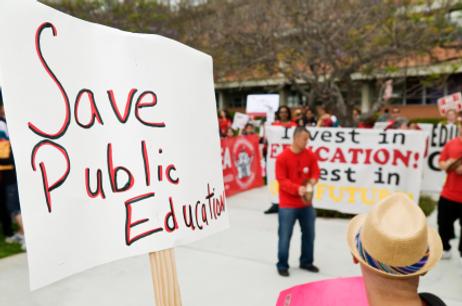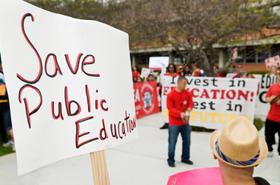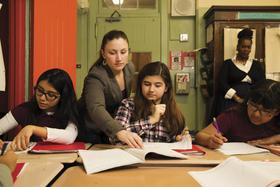Teacher unions have been a part of American education for well over a century, beginning with grassroots efforts to support teachers through improved salaries, benefits, and working conditions. The two national organizations, the American Federation of Teachers (AFT) and the National Education Association (NEA), have paved the way for dozens of state and local teacher associations, often referred to as Independent Education Associations (IEAs). In light of education reform gaining speed nationwide, these teacher unions have recently been put in the spotlight – either as the major hurdle standing in the way of true reform, or a potentially valuable tool in bringing about the sort of change needed in education today.
This video offers an overview of the National Education Association.
History of the Teacher Union
According to the PBS website, the early beginnings of the teacher union can be traced all the way back to the early years of the 20th century, when city boards of education began the first efforts at education reform. While this early focus was positive in some respects - including raising the standards of teaching, ensuring student achievement, and rooting out corruption - teachers at the time did not feel like a significant part of the reform process. Teachers rebelled against the changes implemented by business leaders and education bureaucrats, and they began forming local associations that eventually grew into the teacher unions present today.
In Chicago, the Chicago Federation of Teachers was formed in 1897, and leaders of the movement like Margaret Haley and Catherine Goggin rallied other teachers in the city to demand higher pay, retirement benefits, and teacher tenure. This group laid the foundation for the formation of AFT, which slowly evolved from the Chicago Federation of Teachers to the American Federation of Teachers in 1916. AFT began collective bargaining in the 1940s when they began negotiating with local school boards on a variety of issues.
The National Education Association was formally organized in 1857 as a means for setting education policy. Throughout the first century, after it was established, it played a key role in implementing standards for curriculum development and teacher training. This organization first started as a representative for college and university administrators and faculty members, but gradually expanded by the 1960s to include primary and secondary teachers as well.
This video offers an overview of the American Federation of Teachers.
The Influence of Teacher Unions
Since their inception, the influence of teacher unions cannot be underestimated. According to StateUniversity.com, AFT boasted a membership base of around 900,000 at the turn of the 21st century. NEA had about 2.3 million members at that time, which brings the grand total of teachers affiliated with teacher unions to about three-fourths of all public school teachers.
In addition, IEAs often exert as much influence in individual states as the two larger union groups. For example, one IEA in Texas has more than 100,000 members, and other groups in Georgia and Missouri are larger than either the AFT or NEA chapters in those states. Local Only Teachers Unions (LOTUs) in Indiana and Ohio also boast a significant number of professional members. With so many public school teachers involved with a union, it is no wonder these organizations have come under scrutiny with discussions on education reform. However, their value or detriment within the overall education system is an ongoing debate.
The Benefits of Teacher Unions
When considering whether teacher unions provide real benefit to the student population, statistics may be a viable place to start. Two years ago, National Public Radio interviewed Randi Weingarten, president of AFT. Weingarten told NPR that schools in Singapore and Finland, which are 100-percent unionized, tend to perform better than U.S. schools. States that have more unionization, such as Massachusetts, New York and Maryland, tend to perform better than those with less union participation, such as Mississippi and Louisiana, Weingarten told the Daily Beast.
Weingarten also told the Daily Beast that unions are the ticket to ensuring underserved students get the resources they need to perform academically. She explained, “Having a strong union, an entity that will look at what is done right and what is wrong and solve and change things, is the way to go.”
The Problems with Teacher Unions
Not everyone agrees that teacher unions are the solution – in fact, in an age of serious education reform discussion, many believe they are the primary problem instead. In a report on Fox News, John Stossel states that unions may be good for teachers, but they are bad for students. He refers to an ex-police detective in New Jersey, Jim Smith, who now makes a living investigating “bad” teachers and working through the union-led process of firing them. He describes the process he went through to get rid of a teacher who allegedly hit students.
“It took me four years and $283,000 - $127,000 in legal fees plus what it cost to have a substitute fill in, all the while he’s sitting home having popcorn,” Smith told Fox News.
This video looks at the pros and cons of teachers' unions.
Terry Moe, a professor of political science at Stanford and a senior fellow at the Hoover Institution, agrees that unions create more problems than they solve. Moe told the Daily Beast, “We’re not saying unions are responsible for every problem of the public schools, but they are major obstacles to reform.” Moe adds that it takes on average $200,000, 15 percent of a principal’s time, and two years to get a bad teacher out of schools.
The debate over teacher unions continues to rage, and there doesn’t appear to be a clear decision forming on the validity of unions. However, with education reform at the forefront, one thing remains clear: teacher unions will remain on the hot seat for some time.
Questions? Contact us on Facebook. @publicschoolreview














